EVGA GeForce GTX 680 Classified Review: Pushing GTX 680 To Its Peak
by Ryan Smith on July 20, 2012 12:00 PM ESTPower, Temperature, & Noise
Wrapping up our look at the stock performance characteristics of the GTX 680 Classified, we have what’s perhaps our most important results section: power, temperature, & noise.
When it comes to custom cards these results can often make or break a card, depending on the niche it’s going for. The GTX 680 Classified is a high performing card, but it’s not a card shooting for performance at any cost, so we expect to find some kind of reasonable balance here.
| GeForce GTX 600 Series Voltages | ||||
| EVGA GTX 680C Boost Load | Ref GTX 680 Boost Load | EVGA GTX 680C Idle | ||
| 1.175v | 1.175v | 0.987v | ||
Note that at its stock settings EVGA must follow NVIDIA’s defaults, so the GTX 680 Classified has the same 1.175v load voltage as the reference GTX 680. This is where binning comes into play, as EVGA needs to identify GK104 GPUs that can reach 1100MHz+ at 1.175v in order to make the GTX 680 Classified a viable product.
| EVGA GTX 680 Classified Average Clockspeed | |||
| Game | Clockspeed | ||
| Crysis: Warhead | 1188MHz | ||
| Metro 2033 | 1211MHz | ||
| DiRT 3 | 1211MHz | ||
| Shogun2 | 1162MHz | ||
| Batman: Arkham City | 1188MHz | ||
| Portal 2 | 1211MHz | ||
| Battlefield 3 | 1188MHz | ||
| Starcraft II | 1188MHz | ||
| Skyrim | 1211MHz | ||
| Civilization V | 1188MHz | ||
Meanwhile, looking at the GTX 680 Classified’s median clockspeed during our benchmarks, we can see that our earlier speculation about the impact of such a high power target was true. The maximum boost bin on our card is 1201MHz (versus 1110MHz for our reference card), and with the exception of Shogun 2, the GTX 680 Classified is almost constantly at 1201MHz or the temperature-induced 1188MHz during our tests. With Shogun 2 that drops down to 1162MHz. With such a high power target the resulting clockspeeds are very consistent for a GTX 680 card.
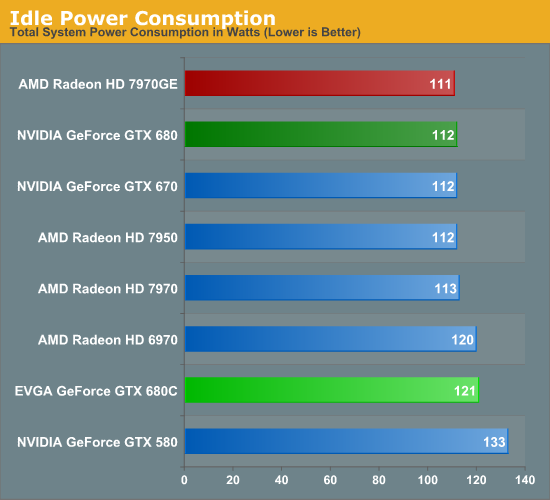
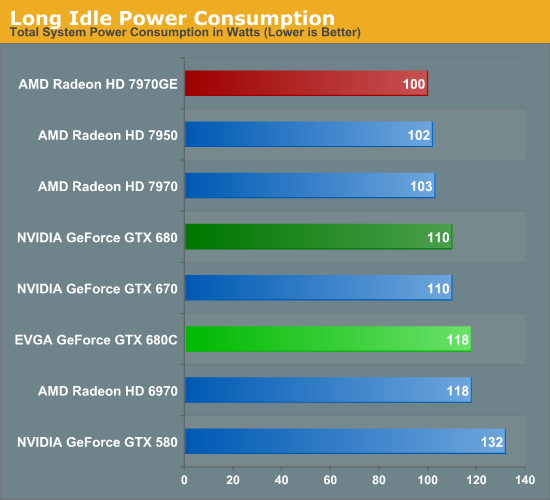
Moving on to power consumption, there are no great surprises here for the GTX 680 Classified when it comes to idle power consumption. With the additional VRM phases and more importantly 8 extra GDDR5 memory chips, idle power consumption has to go up. The impact is that idle power consumption rises by 8-9W, which would push the total idle power consumption of the card up to around 25W. Note however that this is still better than the GTX 580.
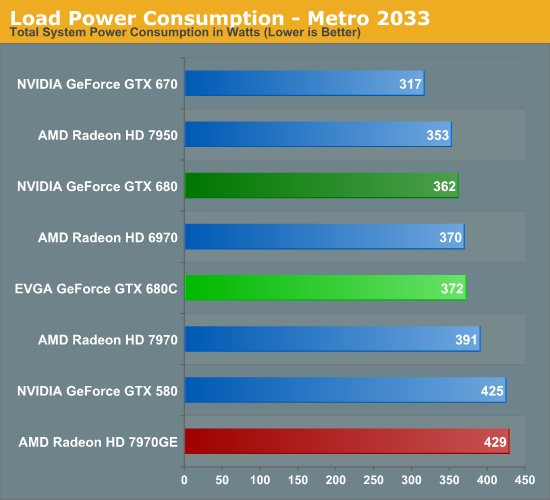
Load power on the other hand looks very good. In fact it’s much better than we were expecting. Despite the additional memory chips and the factory overclock, under Metro power consumption only rises 10W at the wall. This is still less than the7970, let alone the 7970GE.
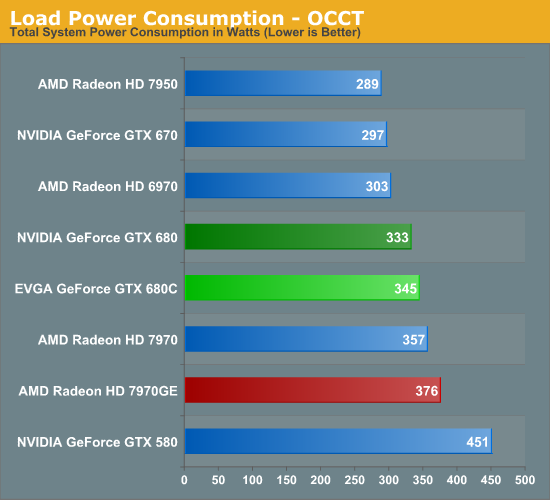
The story with OCCT is much the same. Here we can see that power at the wall increases by all of 12W, which is roughly the remaining difference between the GTX 680 Classified and the 7970. Ultimately the binning process necessary for EVGA to assign GK104 GPUs to their various products has pushed the very best GK104 GPUs into the Classified. The end result is that even at NVIDIA’s standard voltage of 1.175v, the GK104 GPU in our card ends up consuming less power than a more typical GK104 GPU, which allows the GTX 680 Classified to partially offset the higher power consumption of the additional RAM, additional VRM phases, and the factory overclock.
The final result is that the GTX 680 Classified still consumes a bit more power than the reference GTX 680, but not immensely so. Furthermore depending on whether we’re looking at Metro or OCCT, the GTX 680 Classified still draws 30-50W less than the next-nearest competitor, the 7970GE.
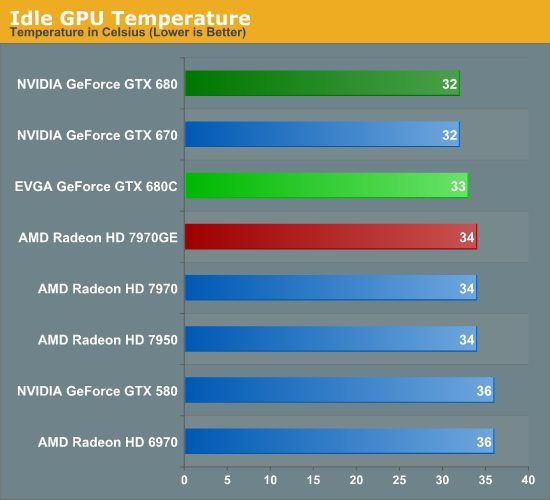
Moving on to temperatures, since EVGA has equipped the GTX 680 Classified with what’s functionally a larger version of the GTX 680’s blower, there are no grand surprises here. The GTX 680 Classified idles at 33C, which so far appears to be typical for these latest iterations of high-performance video cards.

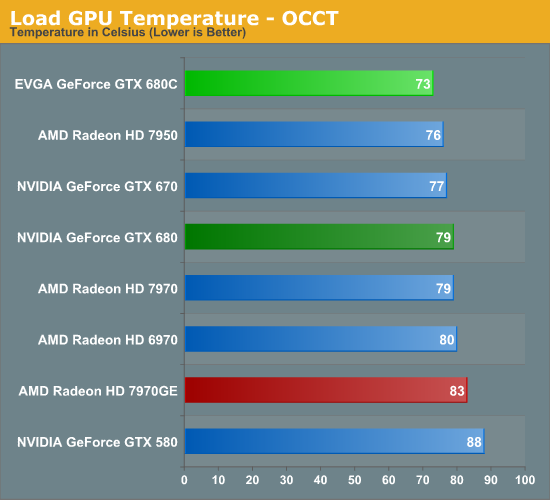
Load GPU temperatures on the other hand are clearly benefitting not only from the larger cooler of the GTX 680 Classified, but also its lower GPU power consumption. With both OCCT and Metro the GTX 680 Classified is 6C cooler than the reference GTX 680. Blowers aren’t known as the most effective coolers, so to reach the low 70s like this is definitely impressive.

Last but not least we have our look at noise levels. Starting with idle noise, the GTX 680 Classified makes no significant tradeoff for its size. Idle noise ends up being a hair higher than the reference GTX 680, but not noticeably so.
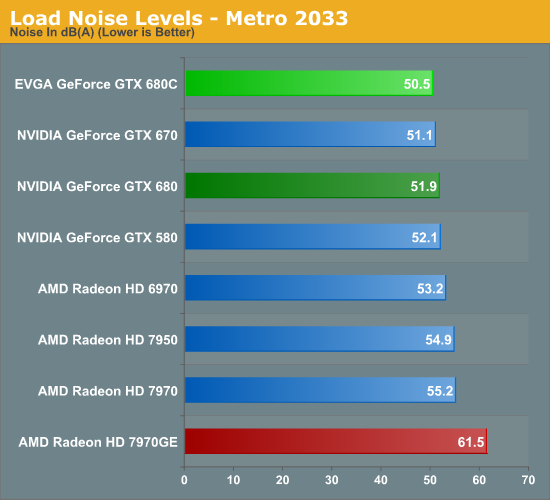
With load noise levels on the other hand we find ourselves once again impressed. The larger cooler and larger fan means that the GTX 680 Classified generates less noise than even the reference GTX 680, which was already a fairly quiet card for its performance level. We had expected EVGA to make some kind of temperature/noise tradeoff here but there’s none to be found. They have managed to lower both at the same time.
Ultimately it’s clear that while EVGA has engineered the GTX 680 Classified for heavy overclocking, they haven’t sacrificed reference performance to get there. When it comes to both temperatures and noise, the GTX 680 Classified is suitably superior to the reference GTX 680. The fact that EVGA did all of this with a blower makes it all the more impressive, since we typically only see gains like these by switching to an open air cooler. Granted these improvements are largely a consequence of the need to overbuild the card for the kind of heavy overclocking it was designed for, but if you do run at stock there are definitely benefits to be realized.










75 Comments
View All Comments
SteveLord - Friday, July 20, 2012 - link
I too have been waiting on a mid range offering. This is crap nVidia.......RussianSensation - Saturday, July 21, 2012 - link
What's wrong with HD7850 for $200-210 or MSI TwinFrozr HD7950 $310, both with 30-40% overclocking headroom? HD7950 @ 1.1ghz > GTX680. No point in waiting for this mythical GTX660Ti.CeriseCogburn - Tuesday, July 24, 2012 - link
You have the mythical $200 or $210 7850 that bottom price is running anyone $220 for the crappiest version around.Why do you people always talk lies ?
HisDivineOrder - Friday, July 20, 2012 - link
nVidia will launch the 660 part on the day the entire Radeon 8xxx series shows up. On the very day.I know I've waited forever and a day for it, too. I've given up hope. I think it's a myth at this point. A story grandpappies tell their youngin's. A tall tale.
The Geforce 660 is a legend wrapped in a mystery drizzled with lies and peppered with vague promise.
RussianSensation - Saturday, July 21, 2012 - link
Rumor: August 16th for 660 series.CeriseCogburn - Tuesday, July 24, 2012 - link
What does midrange mean to you ? The 460 560 560ti 570 580 have "midrange" covered... unless of course you mean non mid mid range, or middler lwor midrange, or range of ranges unranged of which there are none....WHAT are you people expecting ? What cards exactly is this mythical purportedly missing midrange supposed to fall in between for you ?
I'm serious, it's been many, many months, but by logic alone, there isn't a card spot you so desire, and by absolute omission for just as long....
What the freak do you people expect ? The only thing I can possibly imagine is a "midrange card" that falls above the 580, above the 7870, above the 6970, below a stock 670... and costs perhaps "$150=$200" for your "midrange budget" - right ?
I don't get it. Won't one of you midrange wannabes explain it - sometime before it appears, or like is the fantasy supposed to be an absolute mystery forever ?
Galidou - Sunday, August 5, 2012 - link
What do we expect?? Mid range prices with last gen top of the line performance but new gen power consumption and temperatures.... Seems pretty clear to me. Ok you need an example... gtx 560ti between gtx470-480 performance but less power and lower temperatures so I don't have to change power supply if I go sli nor change my case, in the end, save some money and game as well + overclock better.Everything that came out from nvidia from THIS very generation is overkill for gaming at 1080p, and that's the most used resolution in the whole freaking world, end of the discussion... who do you beleive you are criticizing everyone's desire/needs? GOD?
CeriseCogburn - Saturday, August 25, 2012 - link
Ok, well thanks for trying.However, nothing is overkill for 1080P, they ALL have to be turned down except the TOP duals.
So a 680 and 7970 are underkill for 1920 1200 + 1920 x 1080.
Belard - Saturday, July 21, 2012 - link
Remember when the 4850 first came out as a $250 card... yet eventually ended up as a $100 card. Even todays modern $100 video cards are not much faster than the 4850... and that card is over 4 years old!If we go by the usual scale of GPU performance increases at targeted price points...
For today, we should be able to get the performance of a 5870 card at a $100 price.
What do we have? The 6870 is slightly slower than the 5870 (great model naming there AMD - idiots), it costs about $155. (okay, the 5870 was a $500 card).
The smaller and cheaper to make 7850 is slightly faster than the 5870, but it costs about $225?! The 6870 is a better deal since its $75 cheaper yet about 7% slower.
So realistically, the $130 7770 is over-priced as its 2/3rd the performance for a $20~30 savings over the older 6870.
Of course, the 5770/ 6770 and 7770 are all pretty much the same card... not impressive.
RussianSensation - Saturday, July 21, 2012 - link
MSRP for the HD4850 was $199, HD4870 was $299. HD4850 was never $250.I agree with you that most of the performance increase in GPUs has happened in the $250+ level. Although HD7850 OCed = GTX580. The 7850 can be found for $200-230 no problem and GTX580 cost $500 just 1.5 years ago. So it is progress, just not as fast as in the past.
It's too expensive to make fast GPUs in the ~ $100 level. If you can only afford $100-130 GPUs, I think you are better off just getting a PS4 or the next Xbox. The allure of the PC are the games you can't play on consoles, controls, mods and better graphics and much cheaper game prices. $300 for a GPU isn't expensive when you consider the prices of games on the PC.
But ya I agree with you that HD7750/7770 are a joke. The latter is just 25-30% fater than a 2.5 year old HD5770. NV has nothing for less than <$400 (GTX670) worth buying. I guess that's what happens when wafer prices rise and the market for <$100 GPUs disappears.